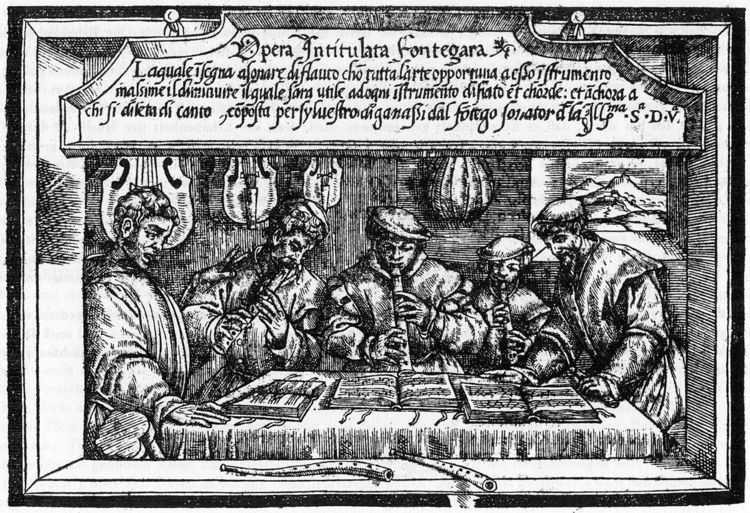Name Silvestro dal Role Musician | Died 1550 Books Regola Rubertina | |
 | ||
People also search for Diego Ortiz, Bettina Hoffmann, Hildemarie Peter | ||
Recorder lesson s ganassi 3 3 la fontegara venice 1535 the art of divisions
Silvestro di Ganassi dal Fontego, also given as Sylvestro di Ganassi dal Fontego, Silvestro Ganasi dal Fontego, and Silvestro dal Fontego (1 January 1492 – mid-16th century) was a Venetian musician and author of two important treatises on instrumental technique.
Contents
- Recorder lesson s ganassi 3 3 la fontegara venice 1535 the art of divisions
- Recorder lesson S Ganassi 13 La Fontegara Venice 1535 the art of divisions
- Viol technique
- References

His first treatise covers recorder playing: Opera intitulata Fontegara (Venice, 1535). His second (in two volumes) is about the viola da gamba: Regola Rubertina (Venice, 1542) and Lettione Seconda (Venice, 1543). They cover both technicalities of playing and the subtleties of expression. There is also guidance on ornamentation—passaggi.
The revival of interest in historically aware musical performance has resulted in renewed interest in Ganassi's writings. His treatises are now available in modern editions.
Recorder lesson, S. Ganassi (1/3), "La Fontegara", Venice 1535, the art of divisions
Viol technique
Ganassi's Regola Rubertina is among the earliest sources of advice to the viol player on how to hold the bow. In Chapter III, Ganassi says:
You know that the bow is to be held with three fingers, that is to say the thumb, the index and middle fingers. The thumb and middle finger ensure, in holding the bow, that it does not fall, and the index finger serves to strengthen and stabilize it, keeping it on the strings and exerting more or less pressure according to the need.
The illustration from Regola Rubertina (lower right, opposite) appears to show this hold. Some interpretations of this passage conclude that the bow is to be held without touching the hair, whereas in later bow-holds the fingers tension the hair in order to allow louder or accented playing without the stick of the bow hitting the string. In a later passage, however, Ganassi makes it clear that the hair may be tensioned with the fingers in at least some circumstances, for example when playing chords to accompany a song:
I can say that if you wished to play a piece which is in four or five parts while singing the fifth, you would need to use a longer bow than is customarily used. This is because the hairs on a longer bow would be less stretched, allowing one to draw the bow with less pressure on the strings while playing a chord. Then you could use the fingers to stretch the hairs when playing fewer strings or a single string.
